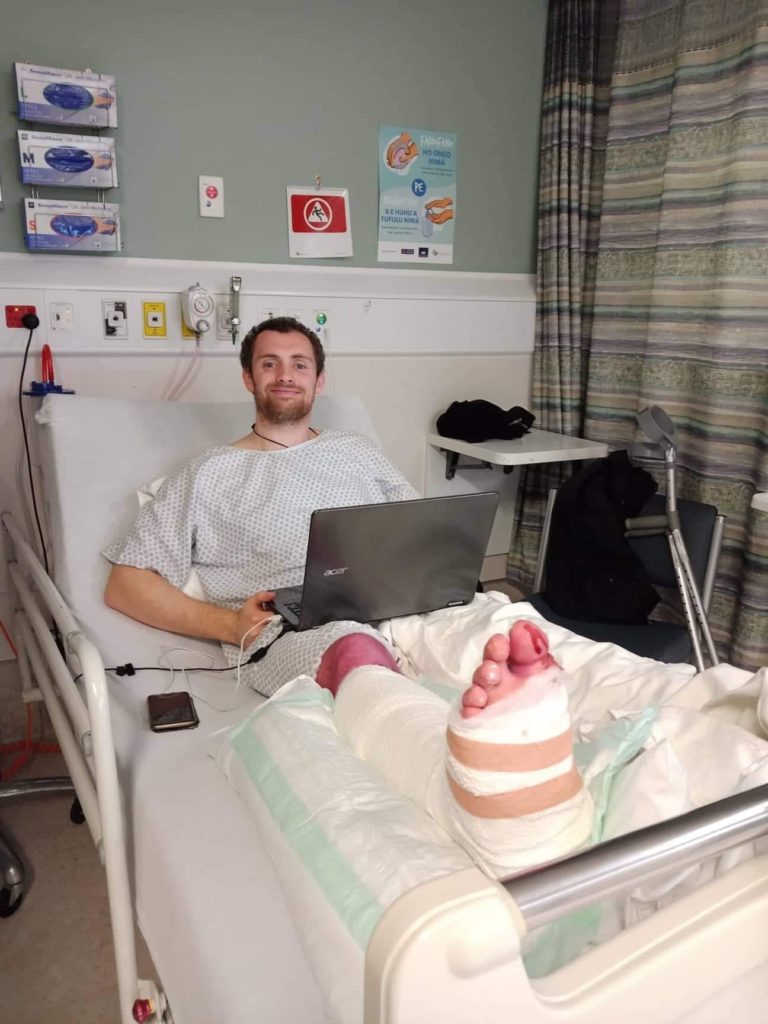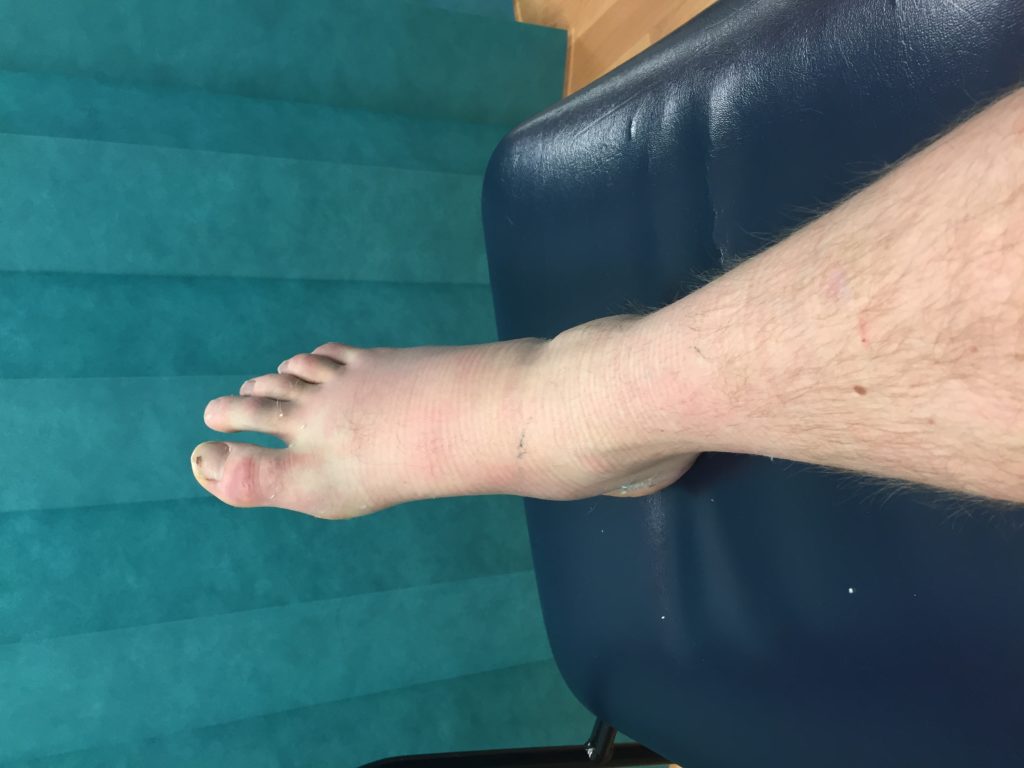I am convinced I must have done some terrible things in a previous life.
I’m writing this from my hospital bed following surgery for a Lisfranc foot injury I sustained 5 days ago playing a club rugby. For the record, a Lisfranc fracture is one of the most commonly missed injuries in primary care, and mine would have fallen into this category had I ignored my gut instinct and followed the advice of the urgent doctors.
But this post is not a gripe about the sometimes sub-par treatment delivered for musculoskeletal injuries in after-hours care, they have a really difficult job with patients that are often in immense levels of pain and discomfort. In this post I’m going to take you through how to not miss a lisfranc fracture, with a first-hand account of what it felt like to sustain it, and what my next steps are on the road to recovery.
Lisfranc Fracture
The Lisfranc joint involves the tarsometatarsal (TMT) joint complex. The injury is usually sustained with the foot in full weight bearing and plantarflexion, with a translational or torsional external force applied to the foot. This causes the small ligaments between these bones to tear and sometimes avulse, resulting in displacement and therefore unstable joints under weight bearing.
Previously, I have seen one case which presented to me after 4 weeks of being in a moonboot and foot pain that was not improving. The mechanism was simple, the patient had stepped down from a curb and stumbled forwards while crossing a road. She felt/heard a popping/crunching sensation at the time and her main complaint was that her foot felt like it was separating under her own weight, pretty much a 1, 2 and 3 of key things to look for should someone present to you with mid-foot pain.
One thing I’ve learned with Lisfranc injuries, is that appropriate radiographs need to be taken as soon as possible. To pick this injury up, it is almost empirical that weight bearing x-rays are obtained as well as non-weight bearing views. This is because the radiologist looks for widening of the Lisfranc joint, which will not be shown in non-weight bearing views.
So it seems pretty simple doesn’t it: A plantarflexed foot under translational/torsional load, popping and cracking sensation through the midfoot (NOT THE ANKLE) and a sensation of separation or the foot being unstable after the injury will make you suspicious of a Lisfranc fracture, with the logical next step being to obtain weight bearing comparison radiographs to rule in/out a Lisfranc fracture.
How I knew I’d broken my foot
It all happened very quickly, but I feel like I had a good handle on the sequence of events. I was stepping a player pushing of my right foot, the tackler made contact so I looked to offload to my left. As I came down in the tackle, I felt the toes of my right foot stick into the ground, and the middle part of my foot roll inwards, with multiple clicks and crunches as I came down. It hurt immediately, and as I went to stand and run to the next phase of play, I felt my foot give way and the bones in the middle of the foot did not feel like they were sitting in the right place. It was a deeply sickening sensation. Even before getting my rugby boot off the swelling had already started, and within 15-20 minutes my foot had ballooned completely with swelling. Putting two and two together, it was obvious that I’d seriously damaged my foot.
I went to urgent doctors as that was the best care available where I was, and they took non-weight bearing x-rays. The initial impression was that there were no obvious misalignment or fractures of my foot, but the radiologist report recommended the weight bearing views be obtained as there was evidence of subluxation of the second metatarsal on the lateral view. Two days later after waiting 5 or so hours in accident and emergency I got the weight bearing views which confirmed a lisfranc fracture. A CT scan shortly followed and 3 days later here I am with two plates and a screw holding the middle part of my foot together. Overall, this is a really good outcome compared to my previous patient that had been walking around for four weeks with a broken foot that was not going to heal by itself.

What comes next?
I’m currently waiting on final x-rays, after which I’m hoping to be discharged to go home. I’ve been told that I will be 6 weeks in cast, and then a further 4 weeks in a moonboot before progression to full weight bearing. Thankfully, a progression of rehabilitation following a lisfranc surgery has already been published by Porter et al. 2019. I’ll leave the link at the bottom of the page but unfortunately the paper is not free to view. I’ll briefly explain the four phases of rehabilitation: (these have been taken from table 4 of the paper by Porter et al. 2019)
Phase 1: 1-6 weeks post-op
Clinical goals:
- Full ROM ankle – dorsi, plantar, inversion and eversion
- Full ROM MTP joints (toes)
- Control swelling
- Desensitize foot
Exercise
- NWB for full 6 weeks
- Toe curls – active and passive
- Achilles tendon stretching with towel
- Strengthening with theraband at 2 weeks all directions of the ankle
- All upper extremity lifting
- Body weight leg extension and curls, seated calf raises in non-weightbearing
Phase 2: 6-12 weeks post-op
Goals:
- Strength comparable to opposite side
- Bilateral double to single toe raise
- Wean out-of-boot into carbon fiber plate and orthotic/athletic shoe
- Proprioception retraining activity in shoe
- Wean off crutches over 10-14 days
Exercise
- Stationary bike in boot until 8-10 weeks post-op
- Proprioception retraining in boot 6-10 weeks post-op and in shoe 8-12 weeks post-op
- Bilateral standing toe raise work to single toe raise
Phase 3: 12-16 weeks post-op
Goals:
- Full ROM, strength and flexibility
- Restore normal proprioceptive retraining at rest/standing
- Begin running, and sports-specific training
Exercise:
- Advanced proprioceptive retraining
- Increase from biking to stair-stepper/elliptical/AlterG to running
- Can begin leg press when able to do stair-stepper/elliptical
- Can do squats/clings/lunges after can run
Phase 4 – 3.5-9 months post-op
Goals:
- Removal of hardware typically at 3.5-5 months post-op
- Return to sport is 4-6 months for high school, 5-8 months for college and 6-10 months for professional athletes
Exercise:
- Sports specific performance exercises and conditioning for full play
If you have made it this far, thank you and stay tuned for updates on my progress via my instagram @theinjuredphysio. Let’s get back to rehabbing together!
References:
Mora, A., Lunz, D., & Kao, M. (2018). Return to sports and physical activities after open reduction and internal fixation for Lisfranc injuries in recreational athletes. Foot & Ankle Orthopaedics, 3(3), 2473011418S0036. doi: 10.1177/2473011418s00361
Porter, D., Barnes, A., Rund, A., & Walrod, M. (2018). Injury pattern in ligamentous Lisfranc injuries in competitive athletes. Foot & Ankle International, 40(2), 185-194. doi: 10.1177/1071100718802264
Singh, S., George, A., Kadakia, A., & Hsu, W. (2018). Performance-based outcomes following Lisfranc injury among professional american football and rugby athletes. Orthopedics, 41(4), e479-e482. doi: 10.3928/01477447-20180424-03


